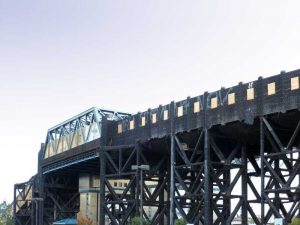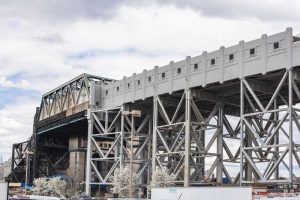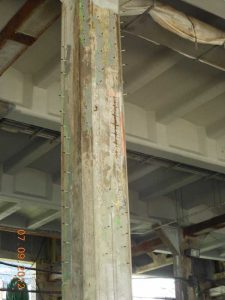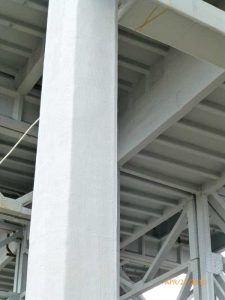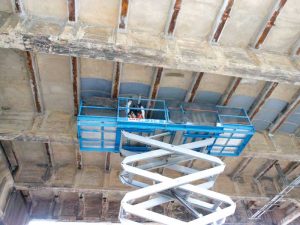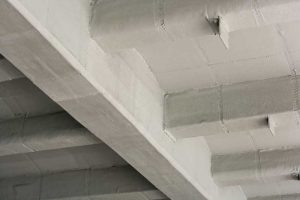Rehabilitating the Culver Line Viaduct with Composites
When it comes to rehabilitating bridges, an increasingly attractive answer is composite materials. Composites are made from two or more distinct materials that, when combined, produce a stronger and better material offering lighter weight, corrosion resistance, versatility, and overall cost-effectiveness. These qualities are ideal for maintaining fragile historical bridges, safely installing prefabricated decking, and curbing long-term maintenance needs. Perhaps no North American project demonstrates the benefits of rehabilitating with composites more than that of the New York Subway System’s Culver Line Viaduct.
Constructed in 1933 to allow tall-mast ships to pass below it on the Gowanus Canal, the Viaduct is a crucial part of the most extensive rapid transit system in the world. It supports four tracks, two subway lines, and two stations including, at 87.5 feet, the highest aboveground station in the world, the Smith-Ninth Street stop. It spans roughly one mile and serves nearly 90,000 “straphangers” each day.
While the number of New Yorkers who rely on the Viaduct each day has only grown with time, its structural integrity has done just the opposite. The enemy of all structures, water, was able to infiltrate the Viaduct, which lacked any form of waterproofing, and progressively caused significant corrosion of the rebar and steel support members. Over time, as the rusting of the steel expanded, the surrounding concrete began to crack and spall. By the 1990s, the concrete had deteriorated so severely that the danger posed by sporadically falling concrete forced the NYC Transit Authority to act.
The Authority opted for an initial stopgap measure, wrapping the Viaduct in a black mesh netting system in 2003 to catch and contain the crumbling concrete. This solution stayed in place for nearly a decade due to budget constraints but, in 2012, the Authority accepted that an extensive top-to-bottom approach was required to successfully address water damage, prevent future water infiltration, and conduct structural repairs, all while keeping the line safe and operable for the traveling public. Among the challenges facing the NYC Transit was how to keep this vital link open while conducting repairs below.
To inform this approach, the Authority took stock of the many challenges that any solution would need to address:
- The mesh netting system hides unknown substrate conditions.
- The complex geometry of structural elements including the intersection of deep beams, joists, and arched soffits.
- An urban setting that included areas abutting privately-owned apartments, homes, and public parks below.
- The continued service of the Subway’s F and G trains, meaning that all work areas would need to be accessed from below.
- Lack of funds or time to fully rebuild or repair.
The Authority’s planners and engineers investigated many options before concluding that the best action was to wrap the Viaduct in a unidirectional, 27 ounce/square yard, epoxy-impregnated glass fiber reinforced polymer (GFRP) fabric, thereby creating a 100% waterproof exterior membrane that would confine and protect all patched areas from further degradation and significantly extend the Viaduct’s service life. Infrastructure specialist Sika Corporation was chosen for the project, not just for their expertise in FRP composite materials but also for their overall knowledge of concrete repair, protection, and corrosion management.
The decision to pursue a long-term solution that included a flexible, fully-customizable material was immediately validated when the stopgap black netting was removed. Inspectors and the contractor began assessing the condition of the concrete and the best method of repair on a section-by-section basis. As Dave White, P.E., Vice President of Technical Services for Sika and the supplier’s chief engineer, put it, “When we removed that netting, it was not a pretty sight. We knew the deterioration would be significant, but we underestimated what the worst areas would look like and how variable the conditions would be.”
In many areas, the corrosion damage was so severe that large sections of concrete had to be chipped out with demolition hammers, while in others the existing concrete surface was greater than a ¼-inch CSP-9 (concrete surface profile) per ICRI Guideline No. 310.2R and needed to be leveled out with repair mortars to fortify the surface. Most of the spalled concrete, especially in overhead repair areas, was patched with a polymer-modified, hand-applied mortar containing an integral corrosion inhibitor. All exposed steel and reinforcing bar was cleaned and protected with an epoxy-modified, cementitious anti-corrosion coating that would provide further protection from carbon dioxide, chlorides, and even acid rain. For the larger-scale and full-depth repairs, a polymer-modified, self-consolidating concrete mixture containing a migrating corrosion inhibitor was used. All cracks greater than 10 mils in width were pressure injected with a low-viscosity epoxy resin prior to FRP repairs.
These many tasks were made more challenging by the complex geometry of the structural elements comprising the Viaduct, including its many intersections of deep beams, joists, and arched soffits. The specified GFRP fabric was flexible enough to allow the contractor to precisely follow the contours of the concrete surface while working high above the ground. Another consideration was the owner’s concern about maintaining the breathability of the underlying concrete which, in many areas, had become quite saturated over the years due to the absence of a waterproofing membrane. Sika, along with its partner Fox Industries, Ltd., met these challenges by custom cutting the fabrics to meet the unique geometric patterns of the elements and maintaining a gap of two to three inches between adjacent sheets of fabric to ensure adequate ventilation of the concrete and prevent full encapsulation of the structure. As White said, “there is simply no other product that would have provided us with the customizability that this highly unique and variable structure required. Furthermore, we recognize that projects like this are not only huge investments but also extremely serious given the tens of thousands of people who rely on this kind of infrastructure. We conducted rigorous quality control testing prior to and throughout the project to ensure correct, safe, and durable installation.”
On the job, the contractor and owner’s inspector were required to verify their work performance as it took place, and each maintained daily logs to keep track of the temperature, humidity, site conditions, batch numbers, crew members, and quantities of material installed. Also, Sika required a trained field supervisor be present onsite at all times to verify surface preparation, resin mixing, application of repair materials, and protective coatings to verify the strength and condition of the substrate. Specifically, tensile bond testing was conducted on a daily basis to verify the adhesion of the repair materials to the concrete substrate. As required in the specification, all tensile pulls achieved a minimum bond strength of 200 psi (1.38 MPa) with failure in the substrate to fully develop the capacity of the repair materials. Lastly, Sika ensured proper bond and long-term performance by taking regular surface moisture, temperature, and relative humidity readings while also preparing and sending out cured witness panel specimens to an outside lab to verify tensile strength, modulus, and elongation properties.
All the testing in the world could not prove the strength, durability, and resiliency of GFRP as powerfully as its ability to weather Hurricane Sandy, which struck New York City midway through rehabilitation in October 2012. Deemed “the storm of the century,” Sandy brought 100-mph winds and a 14-foot storm surge to the City. Moreover, while it shut down the entire NYC Subway System from October 28-30, delaying the project for those three days due in part to workers’ inability to reach the work site, portions of the Viaduct that had already undergone repair work were left unscathed. While other structures in the city were damaged significantly (like the Brooklyn Battery Tunnel, Hudson River Tunnel, Hunts Point Market, etc.), the Culver Line Viaduct was up and running in a few days because the installed GFRP materials remained intact, despite not yet being completely repaired.
In addition to the structural upgrades and waterproofing of the Culver Line Viaduct, which will provide many more years of service to the aging structure, the entire superstructure was coated and protected with a brand new acrylic, waterproof, anti-carbonation coating. Not only does the coating offer excellent resistance to UV attack, salt water, and pollution, it improved the aesthetics of the viaduct and the neighborhood, especially when compared to the black netting that completely shrouded the structure for the 10 years prior to repairs.
An increasing number of federal, state, and local authorities and engineers across the country are following the NYC Transit Authority’s lead and turning to composite materials to fortify and preserve essential infrastructure in a smart, efficient, and cost-effective way.
Considering that the Department of Transportation’s latest assessment reported that infrastructure improvements require a total investment of $926 billion, with transit, rail, and bus systems alone requiring $26.4 billion a year, they are deciding that the time for stopgap measures and short-term investments is over. Taking to heart the words of the report’s author, “We must increase investment in public transportation nationwide because we must take immediate action to bring our transit infrastructure into a state of good repair and provide the world-class service that Americans deserve.” It’s time to give current and future generations of U.S. travelers the reliable infrastructure our nation requires. Whether used alone or in combination with traditional materials, composites have the advanced capabilities and long-term advantages needed to shepherd in this much-needed new era of infrastructure.▪

